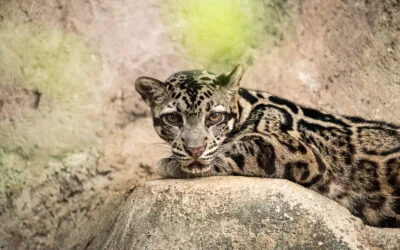Physical description of Clouded Leopards
The clouded leopard is considered to be one of the big cats although it is not part of the Panthera lineage. Larger individuals are 1 meter long, and half a meter in height. The tail is nearly as long as the body and assists balance for climbing.
Short legs (relative to other big cats) and flexible ankles help propel them up trees. The body form led early researchers to believe that most of their time was spent in trees, however in recent studies, it appears that the opposite is true. Females are slightly smaller than males.
The clouded leopard bears distinctive markings. The fur is tinged beige to yellow to grey with large black spots, which are not a uniform shade. Each spot comprises an outline of a large dark patch containing their standard color blended with darker fur. This is the ‘clouded’ effect.
Facial features are distinguished by black spots with white markings. The spots on the limbs and tail are almost entirely dark whilst the underside is lighter than the rest of their fur.

Distribution and habitat of Clouded Leopards
From the Himalayas of Nepal through to Southeast Asia, the elusive Clouded Leopard lives in the jungles and mountains, and is notoriously difficult to find.
In the seclusion of forest depths and rugged mountain terrains, these mysterious cats evade human interaction and are shielded from keen observation. They are tree climbers, but predominantly ground-dwelling and ground-hunting cats.
Clouded leopards live in the forest biomes throughout Southeast Asia and into China, however, they are ideally suited for the tropical jungle. Though less common, they have occasionally been spotted in grassland areas.
Clouded Leopard behaviour
The behavior of clouded leopards is relatively unknown. As active climbers, it was initially thought that they were more arboreal. However, recent discoveries suggest that ground-based hunting and living is prevalent, though they rest in trees.
This survival skill protects them from larger predators such as tigers, though tigers have been severely reduced in much of its range. Their agile body is well adapted for trees, with flexible ankles which enable a griphold of curved branches and trunks.
Active both during the day and night, it is difficult to ascertain their preference. Nocturnal activity is currently perceived to be a trait.
Although little is known of how they interact with each other, it is interesting to note that the ranges of males and females are similar. In the majority of cat species, the male habitually has a greater range that overlaps the territories of multiple females. However, radio-tracking data disproves this behavior in clouded leopards. Modern technology, such as GPS and camera traps, will soon provide us with definitive evidence.
Communication is via markings and vocalizations. It is evident that they communicate with each other in captivity. Since few encounters in the wild have been recorded, it isn’t straightforward to determine what is standard. Claw marks and spraying are, akin with other cats, used to mark territories.

What do Clouded Leopards eat?
Clouded leopards prey on a wide range of species. Being somewhat arboreal, they hunt birds and monkeys more than other cats. Muntjac and sambar deer species are on the larger side of their prey, but more commonly, they hunt smaller deer and wild boar.
Prey is usually dispatched with a single bite to the back of the head. Clouded leopards will occasionally feed on domestic livestock.
Mating and Parental care of Clouded Leopards
Observing the mating behavior of these elusive jungle cats in their native habitat has been scant. Contemporary research knowledge is evidently limited to captive breeding programs, most notably, the young are born with fully formed dark spots. The clouded effect is apparent from six months. As they mature, the cubs become active, and after a couple of months begin to climb trees.
After a three to four month gestation period, up to five cubs are born in each litter. During the first eight to ten weeks, the cubs are nursed, then weaned onto prey that the mother catches. Whilst they may be capable of hunting for themselves from this time onwards, the cubs remain with the mother for almost ten months to hone their hunting skills for self-sufficiency and independence.
Who preys on Clouded Leopards
Humans are the largest threat to clouded leopards, which are hunted for their fur. Ceaseless habitat destruction began at the advent of the 21st century, and is a major contemporary threat.
Tigers and leopards would ordinarily be potential predators, but the larger cats’ populations have been decimated, so that they do not pose a significant threat anymore. Considered a reasonably large predator themselves, the clouded leopard isn’t threatened by many terrestrial mammals.
Impact of Clouded Leopards on the human economy
Unfortunately, clouded leopard pelts are exploited and illegally traded in the two main regions of Taiwan and China.
There is also rampant demand for the use of their body parts in traditional medicines, despite such remedies having been proved to be ineffective. The cats are also captured and traded as exotic pets.
The clouded leopard is large enough to prey on livestock. While full-grown cattle are a sizable challenge, calves, pigs, sheep and goats are relatively easy targets. The destruction of the cats’ habitat as a consequence of over-population, has led to increased human-cat conflict.

Conservation status and human impact on Clouded Leopards
The IUCN states that the clouded leopard is vulnerable, and trade has been restricted by CITES since 1975. This has done little to protect them from the threat of rapid deforestation and growing human populations.
With the exception of Laos, hunting has been banned throughout the range of the clouded leopard. This, and the prohibition of owning exotic pets has had minor effect due to the lack of proper enforcement. Extensive poaching and hunting by farmers continues to endanger dwindling numbers.
National parks have been created to help protect the cat, but the elusive nature of this dense jungle-dwelling creature further complicates an accurate headcount. Even more so, it is challenging to discern whether conservation efforts are having a positive impact.
Other important information about Clouded Leopards
The subspecies Neofelis nebulosa brachyura from Taiwan is probably extinct.










